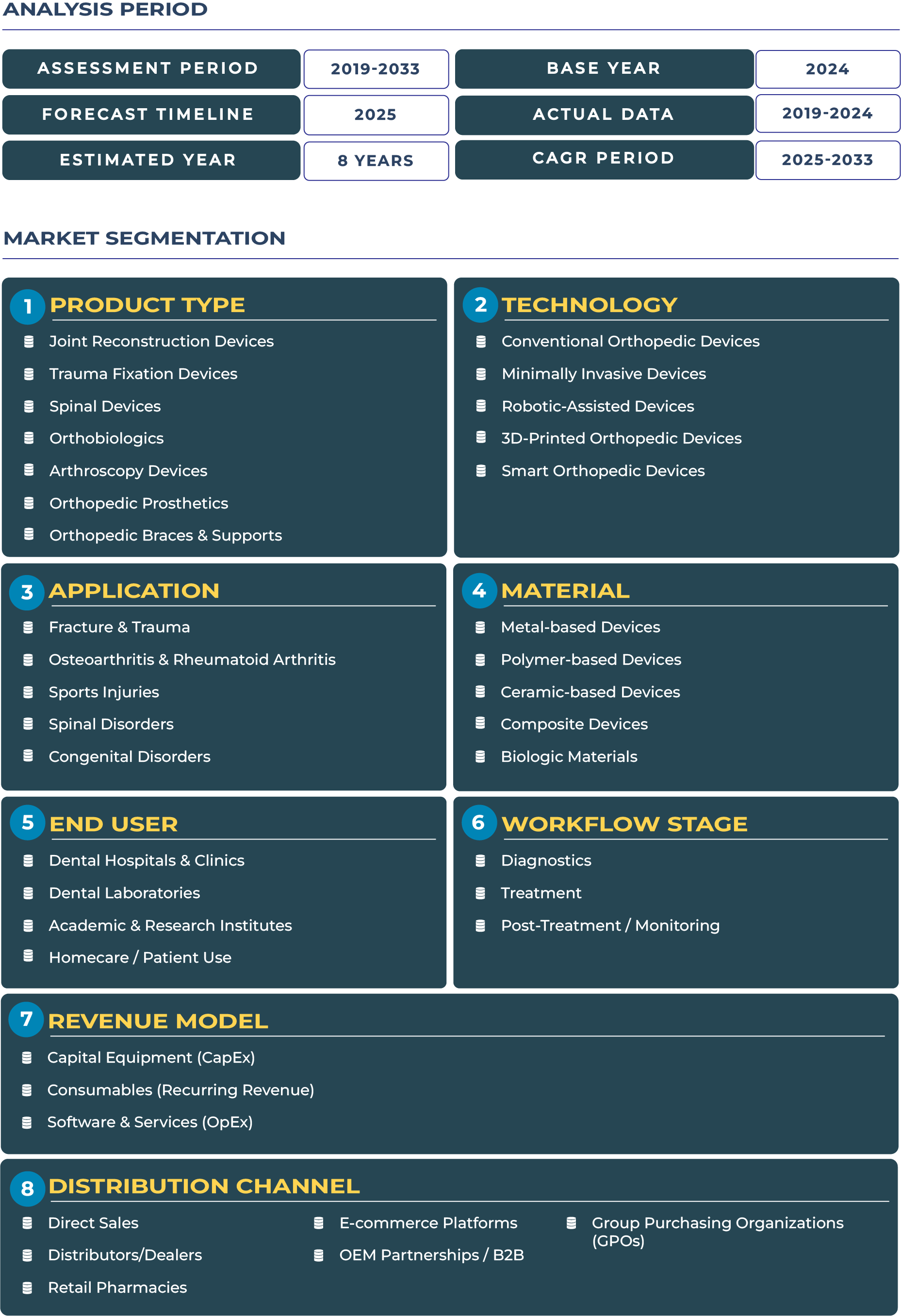Report Format:
![]()
![]() |
Pages: 110+
|
Pages: 110+
Regulatory and Investment Powerhouse: Understanding the Growth Dynamics of the US Orthopedic Devices Market
The United States stands as the single largest orthopedic devices market globally, shaped by its stringent regulatory ecosystem, massive patient volumes, and an unmatched capacity to attract global investments. The U.S. Food and Drug Administration (FDA) sets the benchmark for device approvals, creating a framework where innovation must meet rigorous safety and efficacy standards. This ensures that joint reconstruction, trauma fixation, and spinal implants entering the market are clinically validated and scalable across healthcare systems. With significant venture capital funding directed into medtech startups, the U.S. orthopedic devices ecosystem benefits from a constant pipeline of innovative products.
The US orthopedic devices industry is expected to expand from USD 23.35 billion in 2025 to USD 28.19 billion by 2033. This performance reflects the balance of strong drivers—such as high surgical volumes and advanced robotic adoption—against pressures like reimbursement complexities and rising litigation risks. Additionally, increasing mergers and acquisitions among device manufacturers, coupled with growing clinical trial activity, reinforce the nation’s position as the regulatory and investment powerhouse of the orthopedic devices landscape.
Key Growth Drivers and Market Restraints Reshaping the US Orthopedic Devices Sector
High Surgical Volumes and Robotics Driving Accelerated Adoption
The U.S. leads the world in orthopedic surgical procedures, with millions of joint replacement and trauma surgeries performed annually. The high private pay mix in urban centers such as New York, Los Angeles, and Chicago further fuels demand for advanced implants and premium devices. Robotics adoption in knee and hip replacement has become a defining feature of the industry, with hospitals leveraging precision-driven surgical systems to improve outcomes and reduce revision rates. The expansion of specialized ambulatory surgical centers has added another layer of momentum, allowing faster procedural throughput and positioning the U.S. as a hub for technological integration in orthopedic care.
Medicare Constraints and Litigation Risks Hindering Market Agility
Despite its size, the U.S. orthopedic devices market faces significant barriers that moderate its growth trajectory. Medicare reimbursement models exert pressure on hospitals, restricting budgets for high-cost robotic implants and premium orthopedic prosthetics. Long procurement cycles within large integrated health systems further delay the adoption of cutting-edge technologies, placing smaller device innovators at a disadvantage. Litigation risks also represent a substantial restraint; lawsuits around implant recalls or product failures can not only damage reputations but also impose heavy financial penalties. These challenges create an environment where even the most innovative devices must be supported by strong value-based care strategies and compliance frameworks.
Emerging Trends and Growth Opportunities Defining the Future of the US Orthopedic Devices Industry
Private ASC Expansion and Tele-Prehabilitation Setting New Benchmarks
One of the most significant trends transforming the U.S. orthopedic devices ecosystem is the rapid expansion of private ambulatory surgical centers (ASCs). These facilities are becoming the preferred setting for joint and trauma procedures due to their efficiency, lower costs, and patient-focused care models. Parallel to this, the adoption of tele-prehabilitation and remote patient monitoring is reshaping pre- and post-operative care. Patients undergoing spinal or joint reconstruction now receive digitally guided recovery programs, reducing hospital stays and improving outcomes. Robotic knee rollouts are further accelerating this transformation, ensuring precise alignment and better patient satisfaction scores.
Robotics-as-a-Service and ASC Partnerships Unlocking New Market Avenues
The next phase of growth in the U.S. orthopedic devices sector will be fueled by service-driven models. Robotics-as-a-Service (RaaS) offerings are enabling smaller hospitals and ASCs to access advanced surgical robotics without heavy upfront investments. Direct distribution to ASCs, bypassing traditional hospital procurement structures, is also emerging as a profitable channel for device manufacturers. Furthermore, clinical-outcomes bundles, which combine implants, consumables, and post-operative monitoring in a single package, are gaining traction among payers and providers. These opportunities align with broader healthcare reforms aimed at cost efficiency, value-based care, and improved patient outcomes, making the U.S. orthopedic devices market increasingly opportunity-rich.
Competitive Landscape: Strategic Realignments in the US Orthopedic Devices Market
The competitive landscape is dominated by global leaders such as Stryker, Johnson & Johnson MedTech, and Zimmer Biomet, alongside specialized innovators advancing orthobiologics and arthroscopy technologies. A defining feature of the U.S. market is the strategic creation of ASC-focused commercialization teams that prioritize outpatient settings where procurement cycles are shorter. Companies are increasingly offering outcomes guarantees to align with payer expectations, ensuring device performance is tied to measurable results. Local training centers across major states like California and Texas have been launched to accelerate surgeon adoption of robotic-assisted systems and new implant designs. In 2024, Stryker expanded its robotic knee systems in multiple U.S. hospitals, signaling the intensifying race for leadership in precision surgery. These competitive strategies highlight a sector that thrives on innovation, adaptability, and alignment with the evolving healthcare delivery model.







